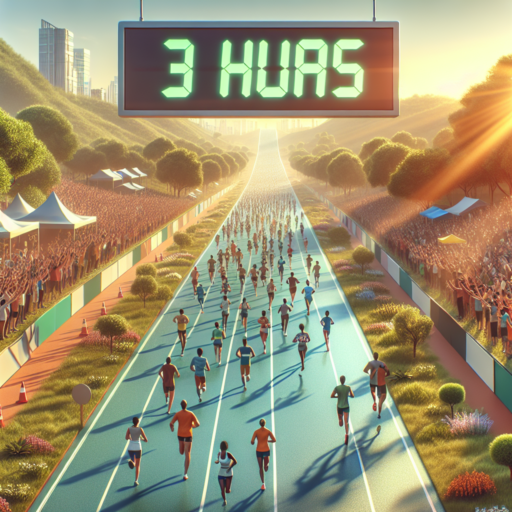What Is a 3 Hour Half Marathon?
Running a 3 hour half marathon is a significant achievement for many long-distance runners, effectively translating to maintaining a running pace of approximately 13 minutes and 44 seconds per mile. This benchmark is often seen as a milestone in the running community, symbolizing a blend of endurance, speed, and unwavering commitment. While it may not set records, achieving this time frame indicates a level of fitness and dedication that goes beyond casual running.
Preparing for a sub-3-hour attempt involves careful planning and a structured training regimen. Runners need to focus on building their endurance, improving their pace, and incorporating various types of training such as interval workouts, long runs, and perhaps most importantly, recovery periods. Nutrition and hydration strategies also play a critical role in preparing for and completing such an endeavor, requiring attention to detail and personalized plans.
It’s important to note that while reaching a 3 hour mark in a half marathon is an admirable goal, it’s not the benchmark for every runner’s success. Each individual’s fitness levels, running history, and personal goals vary widely. For some, simply finishing a half marathon is a dream come true, while for others, it becomes a stepping stone to even more ambitious times or distances. In the end, embarking on the journey to achieve a 3-hour half marathon can be a rewarding challenge, pushing one’s limits and uncovering the true potential hidden within their stride.
Training Tips for Achieving a 3 Hour Half Marathon
Setting the ambitious goal of completing a half marathon in 3 hours requires not only dedication but also a strategic approach to training. To reach this objective, integrating various types of workouts is essential for building endurance, speed, and strength. Below are effective tips that can help you prepare for achieving a three-hour finish in your next half marathon.
Integrate Interval Training
Interval training is crucial for improving your running speed and efficiency. This involves running short distances at a faster pace than your target half marathon pace, followed by brief periods of recovery. For instance, you might run 400 to 800 meters at a pace that is 20 to 30 seconds faster per mile than your goal pace, followed by a couple of minutes of jogging or walking to recover. Incorporating these sessions once or twice a week can significantly enhance your speed.
Long Distance Runs
In addition to speed work, long-distance runs are a staple of half marathon training. Extend your longest weekly run gradually, aiming for at least 13 to 15 miles at a slower pace than your target. This helps your body adapt to the rigors of sustained running, improving your endurance and mental toughness. Ensure you’re consuming enough carbohydrates and staying hydrated throughout these longer runs to maintain energy levels.
Incorporate Strength Training
Strength training exercises play a pivotal role in a comprehensive training plan, significantly enhancing your running performance and reducing the risk of injury. Focus on lower body strength through exercises like squats, lunges, and deadlifts, as well as core strengthening workouts. These exercises should be performed 2-3 times per week to support your running muscles, improve posture, and ensure overall body balance and power endurance.
The Ideal Running Gear for a 3 Hour Half Marathon
Preparing for a 3-hour half marathon means paying close attention to the gear you choose. The right equipment can make or break your performance on race day. Whether you’re a seasoned runner or gearing up for your first long-distance challenge, understanding the essentials is key to crossing the finish line successfully and comfortably.
Footwear: The Foundation of Your Run
The importance of selecting the perfect pair of running shoes can’t be overstated. For a 3-hour half marathon, look for shoes with a balance of support, cushioning, and responsiveness. Models designed for long distances should help reduce the strain on your feet and joints, keeping the common runner’s ailments at bay. Remember, it’s also crucial to have your shoes well broken-in before race day to prevent blisters and discomfort.
Apparel That Beats the Elements
Your choice of apparel can significantly affect your running experience. Opt for lightweight, breathable, and moisture-wicking fabrics to keep you dry and comfortable throughout the race. Layering is key for unpredictable weather, with a light jacket that can be easily tied around the waist if temperatures rise. Additionally, compression gear can enhance blood circulation and reduce muscle fatigue, making it a worthy addition to your running wardrobe.
Essential Accessories for Every Runner
Aside from your basic running attire, incorporating a few essential accessories can greatly influence your half marathon experience. A quality pair of running socks can prevent blisters, while a sweat-resistant, adjustable cap can shield you from the sun or rain. Don’t forget a hydration pack or belt, especially for long races—you’ll need to stay hydrated to maintain your stamina and performance.
Nutrition and Diet: Fueling for a 3 Hour Half Marathon
Preparing for a half marathon is no small feat, and proper nutrition and diet play crucial roles in ensuring your body can sustain the endurance and performance required for a 3-hour run. Understanding the right balance of carbohydrates, proteins, and fats, along with hydration strategies, can make the difference between struggling through the race and crossing the finish line with energy to spare.
Carbohydrates are the primary energy source for endurance athletes, and incorporating a carbohydrate-loading strategy in the days leading up to your half marathon can help maximize your glycogen stores. For a 3-hour effort, it’s essential to increase your carbohydrate intake to about 8-10 grams per kilogram of body weight per day, focusing on complex carbohydrates like whole grains, fruits, and vegetables for sustained energy release.
Pre-Run and During-Run Nutrition
On the day of the race, your pre-run meal should be rich in easily digestible carbohydrates, consumed 2-3 hours before the event, to top off glycogen stores without causing gastrointestinal discomfort. Options such as oatmeal, banana, or a bagel with a small amount of peanut butter can provide the needed energy without weighing you down. Hydration with electrolytes is also paramount, especially in maintaining sodium and potassium levels that prevent cramping during the run.
During the run, maintaining energy levels is critical. Consuming 30-60 grams of carbohydrates per hour can prevent energy deficits, which typically suggest easily digestible forms like gels, chews, or sports drinks that also provide hydration. This strategy helps in sustaining performance and delaying fatigue, ensuring that your body has the fuel it requires to complete a 3-hour half marathon successfully.
Understanding the Pace: How Fast Do You Need to Run?
When considering your running regime, understanding the right pace is crucial for achieving your fitness or race goals. The pace you should maintain largely depends on what you’re aiming to accomplish, whether it’s improving cardiovascular health, preparing for a marathon, or simply shedding a few pounds. However, determining the ideal speed can often feel like a balancing act between pushing your limits and ensuring you’re not overexerting yourself, which can lead to burnout or injury.
Factors Influencing Your Ideal Running Pace
Several factors play into finding your optimal running pace. Firstly, your current level of fitness and running experience are significant. Beginners might start with a more conservative pace, while seasoned runners can tackle faster speeds. Moreover, your goals also dictate your pace; training for speed will look different from endurance training. Lastly, listening to your body and understanding your physical cues is vital. If you’re constantly feeling fatigued or pained, it may be a sign to dial back.
Incorporating a variety of paces into your training can be beneficial. For instance, you might include shorter, faster runs to build speed and longer, slower runs to improve endurance. This method ensures a well-rounded regime that fostarts on both speed and stamina. Additionally, leveraging technology such as running apps and watches can help track your pace and progress over time, offering insights into when and how to adjust your running speed.
- Begin with a pace that feels comfortable but challenging.
- Increase intensity gradually to avoid injury.
- Use technology to monitor and adjust your pace.
- Listen to your body and adjust accordingly.
Remember, the «right» pace is highly individual and can vary from one runner to another. It’s about finding a speed that allows you to meet your objectives while still enjoying the run. With persistence and careful adjustment, you’ll discover the pace that works best for you.
Mental Preparation Strategies for the 3 Hour Half Marathon
Preparing for a half marathon not only requires physical readiness but also a robust mental strategy, especially if you’re aiming to finish in or under three hours. The right mental approach can significantly enhance your performance, turning an ambitious goal into an achievable reality. This guide explores essential mental preparation strategies to empower runners embarking on the 3-hour half marathon journey.
Establishing Realistic Goals
Beginning with a clear and achievable target is crucial. Setting realistic goals not only frames your training but also provides a mental benchmark for your race. Understand your current capabilities and build a strategy that pushes your limits without setting you up for disappointment. This balance between ambition and attainability is key to keeping motivation high and stress levels manageable.
Visualization and Positive Reinforcement
Visualization is a powerful tool for any athlete. Spend time imagining crossing the finish line, the pace you want to maintain, and how you will tackle challenging parts of the course. Positive reinforcement goes hand in hand with visualization. Remind yourself of your training achievements and the hard work you’ve invested. Positive mental dialogues can boost confidence and reduce race-day anxiety.
Tackling the Tough Moments
No race comes without its difficult moments. Anticipating these and having a strategy in place is essential. When you hit a wall, have a set of motivational mantras ready, or remind yourself of why you set this goal. Switching focus from discomfort to the achievement ahead can provide a burst of mental energy necessary to carry you through to the finish line.
Recovery Tactics After Running a 3 Hour Half Marathon
Completing a 3-hour half marathon is a significant achievement, pushing both mental and physical boundaries. However, the recovery process is equally critical to ensure your body heals properly, preventing injuries and preparing for future races. Here, we explore effective recovery tactics tailored specifically for athletes who have conquered this endurance challenge.
Active Recovery Techniques
Immediately after your marathon, consider engaging in active recovery. This can include gentle stretching, walking, or even a light jog in the following days. Active recovery aids in mitigating stiffness and promotes circulation, facilitating the removal of lactic acid build-up. Importantly, listen to your body during this phase and avoid any strenuous activity that could exacerbate muscle soreness or lead to injury.
Nutrition and Hydration
Refueling your body is paramount after enduring the physical demands of a 3-hour half marathon. Prioritize replenishing fluids to replace what was lost through sweat and focus on a balanced intake of proteins, carbohydrates, and fats to aid in muscle repair. Hydration should begin immediately post-race, with an emphasis on electrolyte balance to recover any salt lost. Proper nutrition in the days following the race will support the body’s healing process, boosting recovery.
Adequate Rest and Sleep
A crucial, yet often overlooked element of recovery, is ensuring you get ample rest and sleep. The physical exertion from such a prolonged race can significantly deplete your energy reserves and immune system. Aim for at least 7-9 hours of sleep per night in the week following the marathon. This not only aids in physical recovery but is essential for mental well-being, too. Accommodating your body’s need for rest can expedite the recovery process, preparing you more swiftly for your next athletic endeavor.
No se han encontrado productos.
Success Stories: How Real Runners Achieved a 3 Hour Half Marathon
Achieving a 3 hour half marathon is a milestone many runners dream of, and it’s a goal that requires dedication, strategic training, and sometimes, a little bit of inspiration from those who’ve already crossed that finish line. Throughout this journey, learning from the success stories of real runners who have hit this target can provide invaluable insights and motivation. Let’s dive into how they turned their marathon dreams into reality.
One key theme among successful runners is the importance of a tailored training plan. Most of these runners didn’t just run with the hope of improving; they followed structured training schedules designed to incrementally build their speed and endurance. These programs often include a mix of long runs, speed work, and recovery days, carefully calibrated to push the body’s limits without leading to injury. By listening to their bodies and adjusting their training accordingly, these runners found the sweet spot that allowed them to break past their limits.
Another critical aspect of their success was nutrition and recovery. Understanding the role of proper diet, hydration, and rest played a pivotal role in enhancing their training outcomes. These runners paid keen attention to fueling their bodies with the right balance of nutrients to support intense training sessions and recover effectively. Hydration strategies were also tailored, especially for long runs, ensuring they remained well-hydrated throughout their training and on race day. Emphasizing the importance of rest, many of these individuals incorporated rest days and active recovery into their routines, understanding that the body needs time to heal and strengthen.
Lastly, a strong mental fortitude and community support were indispensable. Mental toughness helped them push through tough training days and the challenging moments of the race itself. Furthermore, surrounding themselves with a supportive community—whether through running clubs, online forums, or training with friends—provided encouragement and accountability, two factors that significantly contribute to reaching such an ambitious goal. By combining these elements with their physical preparation, these runners were not just dreaming of a 3 hour half marathon—they were living it.
Common Mistakes to Avoid in Your 3 Hour Half Marathon Training
Training for a half marathon with a goal of finishing in three hours requires a well-planned approach. Many runners, however, fall into common pitfalls that can hinder their progress and performance. Understanding these mistakes is crucial to refining your training plan and achieving your targets.
One major mistake is inconsistent training. Consistency is key in marathon training, and failing to adhere to a consistent schedule can severely impact your endurance and speed. It’s important to set a realistic training plan that fits into your lifestyle and stick to it.
Another common error is neglecting recovery time. Proper recovery, including rest days and adequate sleep, is essential for muscle repair and growth. Ignoring the body’s need for recovery can lead to fatigue, injury, and burnout, ultimately affecting your performance on race day.
Additionally, overlooking nutrition and hydration can significantly affect your training outcomes. The right balance of carbohydrates, proteins, and fats, along with proper hydration, provides the energy and muscle recovery needed for endurance running. Failing to optimize your nutrition can lead to decreased performance and increased recovery time.
By avoiding these common mistakes, you can optimize your 3-hour half marathon training and set the stage for a successful race. Remember, every detail in your training counts towards achieving your ultimate goal.
Future Steps: Preparing for a Full Marathon After Achieving the 3 Hour Half Marathon Goal
Achieving a sub-three-hour half marathon is a significant milestone for any runner, indicating a high level of fitness and dedication. This accomplishment can naturally lead to the ambition of tackling a full marathon. However, doubling the distance requires not just more of the same training, but a careful expansion of your endurance, strategy, and mental strength.
Expanding Your Endurance Training
Transitioning from a half to a full marathon involves increasing your weekly mileage. This doesn’t mean doubling your efforts overnight—instead, it’s about gradually extending your long runs and integrating more endurance-focused workouts into your schedule. Incorporating slowly building endurance runs allows your body to adapt without risking injury. It’s also crucial to pay attention to recovery, as the increased mileage demands more from your body.
Strategic Nutritional Adjustments
Nutrition plays a pivotal role in enhancing marathon performance. For full marathon training, revisiting your dietary plan is necessary to ensure you’re adequately fueled. Focus on a balanced diet rich in carbohydrates, proteins, and fats, and consider carbohydrate loading before your long runs. Proper hydration strategy is equally important; experimenting during training will help you understand your body’s needs over longer distances.
Mental Preparation and Strategy
Running a full marathon challenges more than just your physical capabilities; your mental stamina is equally tested. Developing a strong mental game involves visualization techniques, setting realistic pacing goals, and having contingency plans for tough moments during the race. Additionally, strategize your race day by breaking down the marathon into smaller, manageable segments, which can make the distance feel less daunting. Remember, transitioning from a half to a full marathon is as much about psychological preparation as it is about physical training.



